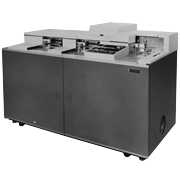The Hitachi H-8252 optical character reader was a document reader that could read characters and marks on relatively small forms. The reader was designed primarily to address the need to read turnaround forms. The H-8252 was the first domestically produced general-purpose OCR reader that supported general applications. Document readers were first used in Japan in 1965, and Hitachi entered the market with a U.S.-made OEM product (the H-5820). By producing the H-8252 domestically, Hitachi was able to outfit it with many outstanding features, including processing speeds, reading performance, mechanical assembly stability, and the ease of recovering from an unreadable character. The primary application was reading handwritten marks to meet the need of the life insurance industry to process monthly insurance premiums and the need of power and gas utilities to process meter-reading cards.
| Readable characters | N-2 font (numbers and 14 special symbols) |
|---|---|
| Readable forms | Length: 100 to 215 mm,Width: 70 to 102 mm Thickness: 0.1 to 0.15 mm(paper weight of 70 to 110 kilograms) |
| Processing speeds | Maximum 1,200 cards per minute (when reading 100 mm long forms) |
| Paper-feed control | Selectable from on-demand feeding and continuous feeding |
| Usage configuration | Connected to a HITAC 8000 series computer |
| Sales launch period | 1968 |


